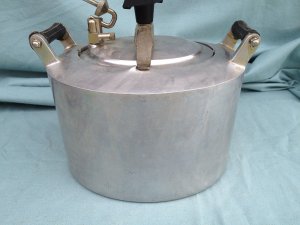jbmauser
Member
I spent time in the library but one important question seems to remain unanswered. I am going to build a pressure pot out of this old pressure cooker. the lid is captured and is sealed with up pressure. I read where one guy runs pressure to 40# the guy who sells cactus juice talked about making a blank from flowers and running up to 80# and still getting some small bubbles.
what is the common or normal working pressure?
Will a pancake air compressor do the trick?
How long do you maintain pressure?
Any safety tips like run a long hose and put it outside?
Not looking to add any more excitement to my life, just cast a few blanks!

View in Gallery
what is the common or normal working pressure?
Will a pancake air compressor do the trick?
How long do you maintain pressure?
Any safety tips like run a long hose and put it outside?
Not looking to add any more excitement to my life, just cast a few blanks!

View in Gallery
